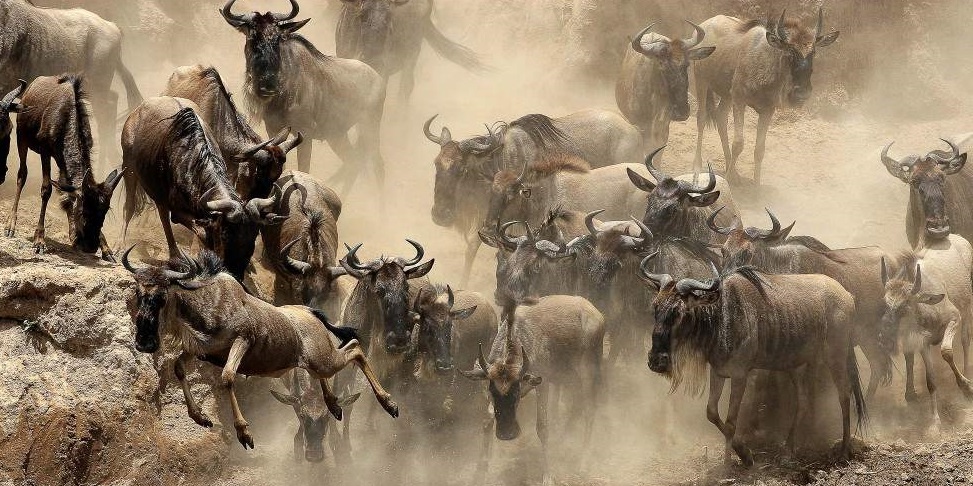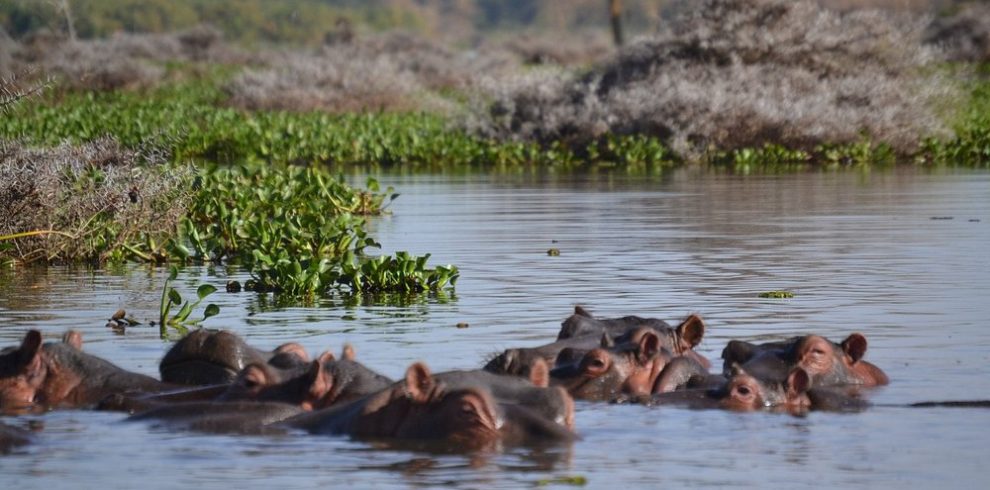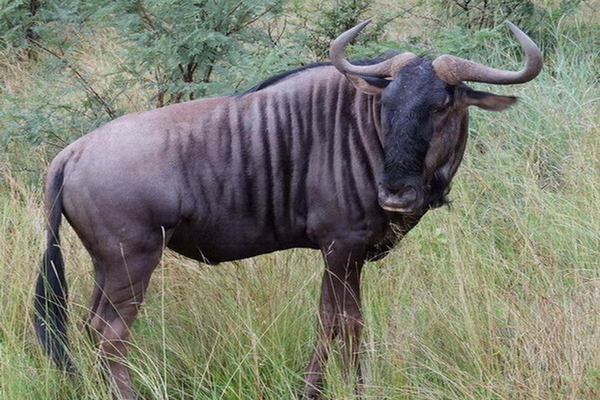
The Blue Wildebeest (Connochaetes taurinus) is one of the most iconic animals found across the African savannas and grasslands. Reputed to be one of the best migrating animals on earth, having its own distinctive look, and social behavior out of this world, this antelope has caught the eye of wildlife lovers, scientists, and safari adventurers. Despite being often overshadowed by the more famous members of the African Big Five, the Blue Wildebeest is an integral part of the African ecosystem and holds a crucial role in the natural world.
In this article, we will delve into 5 fascinating facts about the Blue Wildebeest, offering you an in-depth understanding of this magnificent animal. From its distinctive features and behavior to its migration patterns and survival strategies, these facts will highlight why the Blue Wildebeest is a captivating and essential species to admire.
1. The Blue Wildebeest is Famous for its Annual Migration
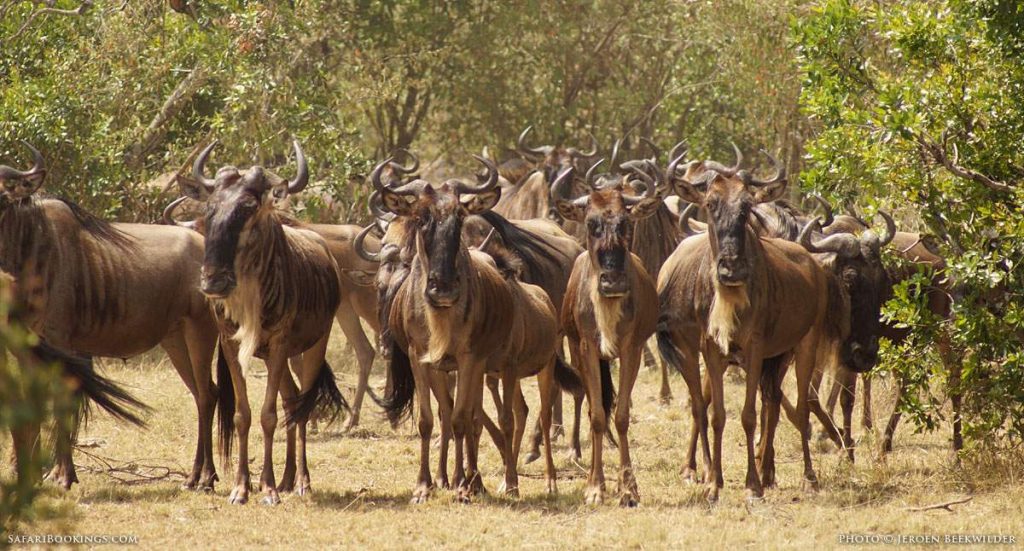
One of the most well-known facts about the Blue Wildebeest is its awe-inspiring annual migration. The Blue Wildebeest is most famous for its role in the Great Migration, one of the most spectacular wildlife events in the world. More than one million wildebeest (and thousands of zebras and gazelles) make a mass animal migration every year in quest of food and water. This seasonal migration is mainly determined by the seasonal variation of rainfall, determining the supply of green pasture and water supply.
The wildebeests use the dry season to scale immense distances as they chase the rains to buffer their grazing grounds. The migration is not an easy straight line that is easy to pursue; it is a rigorous journey which can involve distances of up to 1,000 miles and even beyond. It is one of the most amazing spectacles of animal life and the wildebeests are the heart of it. Throughout this voyage, the herds encounter a number of difficulties, such as the crossing of deadly rivers, evasion of predators, such as lions and crocodiles, as well as the changing weather patterns.
The river crossings, especially the dramatic ones, remain among the most thrilling episodes of the migration when huge masses of wildebeests take on their lives in their hands to cross the crocodile-infested water in a mad dash towards the other side. In addition to the migration, the migration of wildebeest through the Serengeti and Masai mara affects the ecosystem. Having so many herbivores within a certain field can drastically affect the topography and provide a chance of providing new vegetation and equaling other wildlife forms that do need the grazing influence.
2. The Blue Wildebeest is a Unique and Striking Animal

When you first encounter a Blue Wildebeest, it’s hard not to be struck by its distinctive and somewhat unusual appearance. The antelope is very large and its features are a mixture of characteristics and make it appear wild and powerful. The Blue Wildebeest stands out due to its broad, boxy head, large, curved horns, and rugged body.
The horns of the Blue Wildebeest are particularly notable. Both the males and the females are horned, but the male horns are larger and more distinct. The horns of the Blue Wildebeest curve outward and then sweep backward, forming a semi-circular shape. The horns serve both defensive purposes (against predator attacks) and during the rutting season (whereby the males compete with each other to dominate and mate).
The body of the Blue Wildebeest is muscular, built for endurance and strength. They have long and strong legs that enable them to move over long distances during migrations. Their coarse, dark blue-gray fur gives them their name “Blue Wildebeest,” although the color of their coat can vary slightly depending on the individual and the region they inhabit. They have very large, expressive eyes and a black beard, which contribute to their wild look.
The hooves of the wildebeests are also large and flat and enable them to make their way through the uneven terrain of the African plains especially in wet or marshy areas. In addition to their physical features, the Blue Wildebeest’s unique vocalizations set it apart from other antelopes. They are characterized by a grunt-like call that they employ to interact with each other, particularly as they interact during the migration and mating season. This throaty roar is easily recognizable and can be heard over large distances, and is one of the most important methods of how they maintain contact with the herd.
3. Blue Wildebeest Have a Complex Social Structure

Another fascinating fact about the Blue Wildebeest is its intricate and highly organized social structure. The Blue Wildebeest lives in large herds that can range from a few individuals to thousands, depending on the season and the location. Such herds are mostly females with their young and males are usually in bachelor groups or solitary until mating season. Within these herds, social ranking is very high.
Adult males (bulls) have a typical harem of a small number of females. The bulls also protect their harems and would defend the females against other males. Male wildebeests will fight bitterly in order to dominate other wildebeests during the rutting season; using their horns to grapple. The winning male is allowed to mate with the females in the harem. Instead, females prefer strong attachments to other females and their young. These groups ensure safety and support through the difficult migration journey where the possibility of being preyed is high.
The females aid in rearing and guarding the offspring of one another thereby providing a further security layer in the herd. Mothers and calves have a strong bond and the mother will go a long way to ensure her young ones are not attacked by predators. Wildebeests are very social creatures and they heavily rely on the existence of the herd to ensure protection and organization of migrations.
Animals tend to travel in herds moving in big compacted groups and this can overwhelm the predator and disorient them. Group behavior of the herd also aids the wildebeests to locate the most suitable grazing places and move through the dangerous terrains they traverse.
4. Blue Wildebeests Have a Strong Defense Mechanism Against Predators
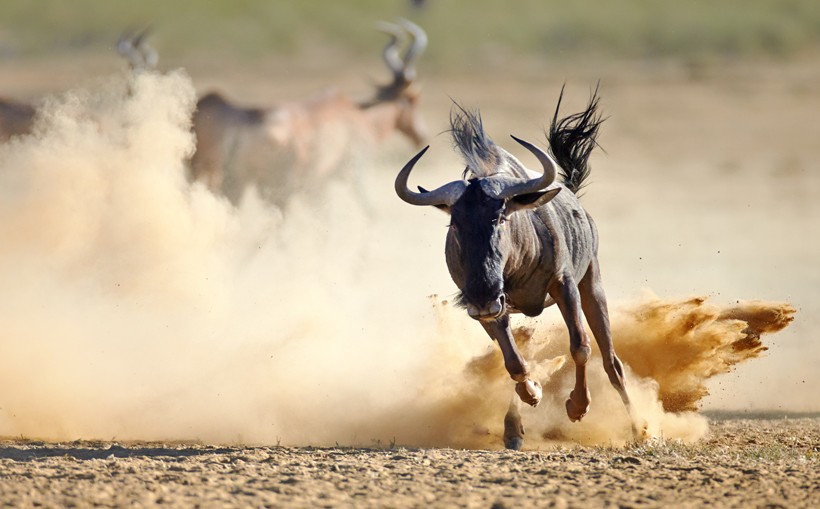
Despite being preyed upon by some of Africa’s largest predators, including lions, hyenas, and crocodiles, Blue Wildebeests have developed strong defense mechanisms that help them survive in the wild. The speed and the ability to be agile is one of the defining characteristics of the defense strategy of the wildebeest. Although they are not the fastest antelope species, Blue Wildebeests are capable of running at speeds of up to 50 miles per hour (80 kilometers per hour) when necessary. In addition to speed, Blue Wildebeests have a powerful and coordinated defense mechanism when they are in groups.
The herd is usually closely ordered and members are standing shoulder to shoulder facing outward to discourage or put off any predators. When predator strikes, the herd will rush, so the predators have a hard time isolating one animal to hunt down. The keen horns also serve as weapons to the wildebeest; especially the bulls, which will employ to fight others or protect themselves and their land in bull-fights. When faced with danger, individual Blue Wildebeests are not afraid to fight back.
The wildebeest can kick or charge a predator that comes too close trying to shake it off. This strong defensive behavior, combined with their speed and agility, makes Blue Wildebeests relatively difficult for predators to catch, although they are still vulnerable, particularly young calves or weak individuals. The river crossing where the thousands of wildebeests attempt to cross crocodile infested rivers has been one of the most renowned scenes of the Great Migration.
The herd mentality of the wildebeests assists in keeping people safe during this dangerous period, as the wildebeests run in groups and attempt to overpower the predators that are waiting in the waters. Many of the wildebeests will lose their lives to the crocodiles, but mass movement of the herd reduces the danger to others.
5. Blue Wildebeests Have a Unique Breeding and Calving Season
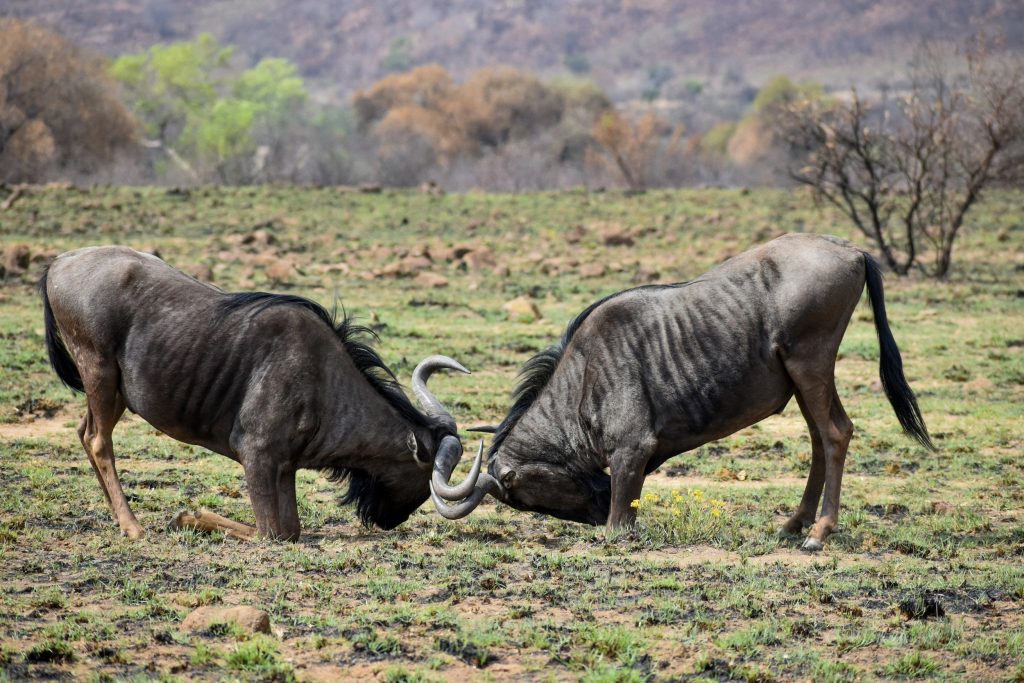
One of the most remarkable facts about the Blue Wildebeest is its synchronized breeding and calving season. The migration pattern is remarkably related to the reproduction cycle in the wildebeest with most of the young being born at the same season. It is believed that, this synchrony increases the survival rate of the calves due to the fact that the herd is observed in an area with sufficient water and food when the young ones are born. Most Blue Wildebeests give birth during the rainy season, typically around February to March, when the grass is most abundant.
The birth time is also important because it enables the calves to enjoy the good grazing pastures, and enables them to be born at the time when predators are at their busiest concentrating on the older and weaker herd members. The calving season is an intense period for the Blue Wildebeest, as the newborn calves must quickly learn to stand, walk, and keep up with the herd to avoid predators. It takes a few hours of a newborn calf to run and escape predators and stay safe in the herd.
But the mortality is very high and not many of the calves reach the age of one year because being at risk of predations. The males can be extremely competitive with each other during the calving season and violent, as the bulls exhibit intense patterns of aggressive behaviors to woo the females. The courting is also fierce with males fighting head-to-head rather demonstrating their dominance. As soon as a male can manage to ensure that he gains domination over a harem, he will mate with the females and keep them until the calving season is over and they are due again.
Conclusion
The Blue Wildebeest is an extraordinary and fascinating creature that plays a vital role in the African ecosystem. From its breathtaking migration to its distinctive appearance, complex social structure, and unique defense mechanisms, the Blue Wildebeest is a symbol of resilience and adaptability. Whether it’s the sight of thousands of wildebeests crossing rivers during the Great Migration or the sound of their deep grunts echoing across the savanna, the Blue Wildebeest continues to captivate all who encounter it.
By exploring 5 fascinating facts about the Blue Wildebeest, we can better appreciate the beauty, strength, and significance of this remarkable animal in the African wild. As we continue to protect these iconic creatures and their habitats, we ensure that future generations will have the opportunity to witness the incredible wonders of the Blue Wildebeest and its role in maintaining the balance of Africa’s ecosystems.

